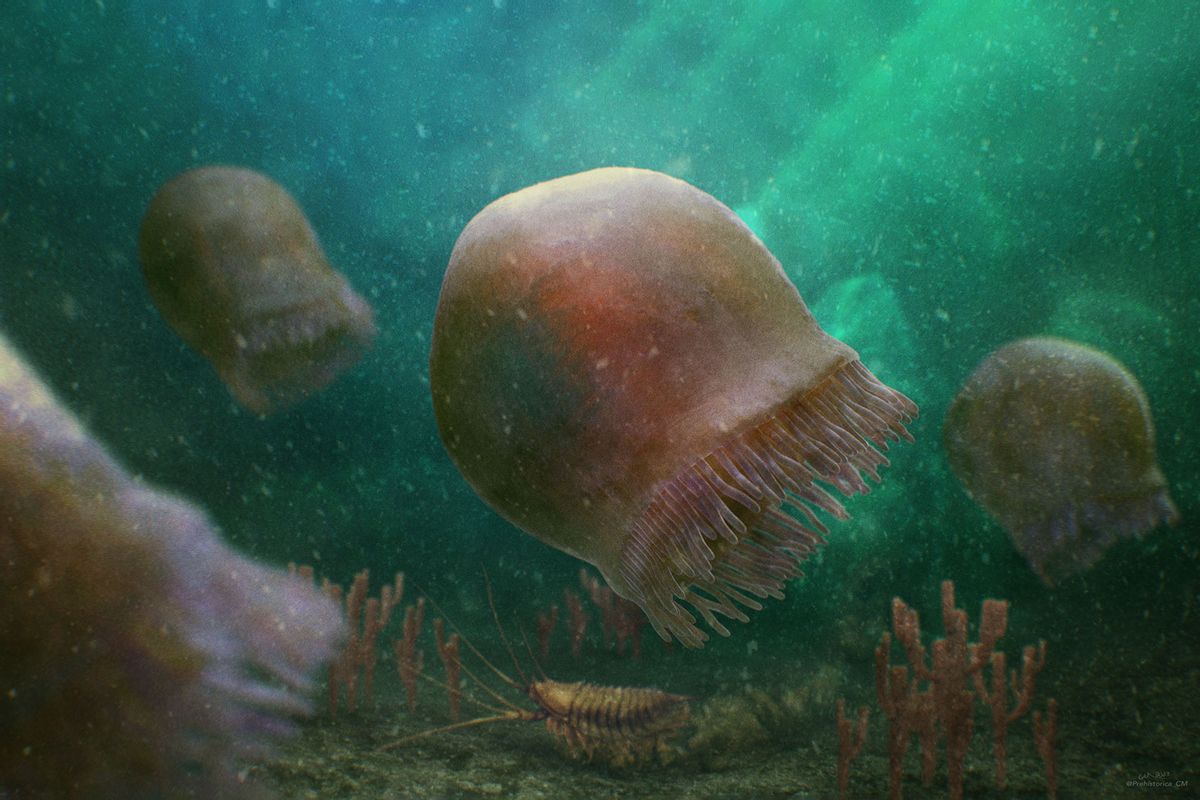When a group of paleontologists dusted off a group of fossils that had been sitting on the shelf at the Royal Ontario Museum in Toronto, Canada since the 1980s, they uncovered a spooky organism with a bell-shaped body and about 90 stubby tentacles extending out from its rim.
The 505 million-year-old fossil revealed the oldest known species of swimming jellyfish, which the research team named Burgessomedusa phasmiformis, according to a study published today in the Proceedings of the Royal Society B.
"That [name] means 'the Burgess Shale jellyfish with a ghost-like form,'" study author Joseph Moysiuk, a Ph.D. candidate at the University of Toronto, told Salon. "We gave it that name because its overall body shape looks a little bit like the ghost from Pac-Man."
Only a handful of jellies have ever been discovered in fossils, (without bones, it's hard to fossilize), including one 2007 discovery in Utah also tracing back to the Cambrian time period, when most animal groups were born. However, Moysiuk says these might have been comb jellies from the Ctenophora phylum, rather than the Cnidaria phylum which includes jellyfish, corals and sea anemones. Although they are similar, the latter is more predatory and mobile.
"We gave it that name because its overall body shape looks a little bit like the ghost from Pac-Man."
The fossils examined by Moysiuk and his team showed the bulbous body of the jellyfish extending up to 20 centimeters, with dozens of flexible tentacles it would have used to swim. Although B. phasmiformis has a box shape similar to one of the most venomous types of jellyfish, it also has a ring of tentacles similar to a group called true jellyfish, Moysiuk said. These traits that resemble many different kinds of modern-day jellyfish provide a glimpse into how the species evolved.
"I think what's neat about this mix of characteristics is it's probably suggesting to us that Burgessomedusa diverged from the line quite deep in that group's history," Moysiuk said. "It's telling us a little bit about the ancestry of the group of jellyfish as a whole."
A jellyfish begins its life cycle as an anemone-like creature on the sea floor before undergoing a metamorphosis and sprouting into a recognizable medusa — that Pac-Man ghost shape we're all familiar with. Jellyfish have also been identified in fossils in this time period in these earlier forms, suggesting this transformation began at the species level at least 505 million years ago.
Want more health and science stories in your inbox? Subscribe to Salon's weekly newsletter The Vulgar Scientist.
The Anomalocaris canadensis, a long arthropod with spiny claws resembling a shrimp, is thought to have been a major predator during the Cambrian era. But in one fossil Moysiuk's team worked with, they discovered evidence that suggested the Burgessomedusa phasmiformis might have given it some competition as an ancient predator underwater.
Within the bell shape of one fossil, researchers found additional fossils from relatives of modern-day crustaceans and spiders. Although this was only found in one sample, the presence of these critters suggests this ancient creature was carnivorous, like jellyfish that feed on plankton and crustaceans today.
The presence of these critters suggests this ancient creature was carnivorous, like jellyfish that feed on plankton and crustaceans today.
"It's possible this represents some kind of predatory interaction preserved in the fossil," Moysiuk said. "But since we only have one specimen, we can't be certain that it's not just a chance occurrence."
The fossil was uncovered from a region known as the Burgess Shale, a designated UNESCO World Heritage Site in Yoho National Park in British Columbia, where fossils of arthropods, predators and even some of the oldest human ancestors have been found.
Typically, jellyfish are uncommon in the fossil record because squishy, soft materials like jellies don't preserve as well as hard materials like bones. Because of the conditions in the Burgess Shale, which was likely buried rapidly in an underwater mudslide, many soft tissues like brains, eyes and digestive organs were preserved.
We need your help to stay independent
It's there that B. phasmiformis swam among the shrimp-like Anomalocaris canadensis (and other creatures we've yet to discover) that paved the way for life as we know it today.
"Jellyfish have been so elusive in the Cambrian fossil record, and yet we think jellyfish are one of the earliest groups of animals to diverge," Moysiuk said. "This discovery helps fit that final piece in and complete our picture of how much animal diversity was already existing in the Cambrian period."
Read more
about paleontology



Shares